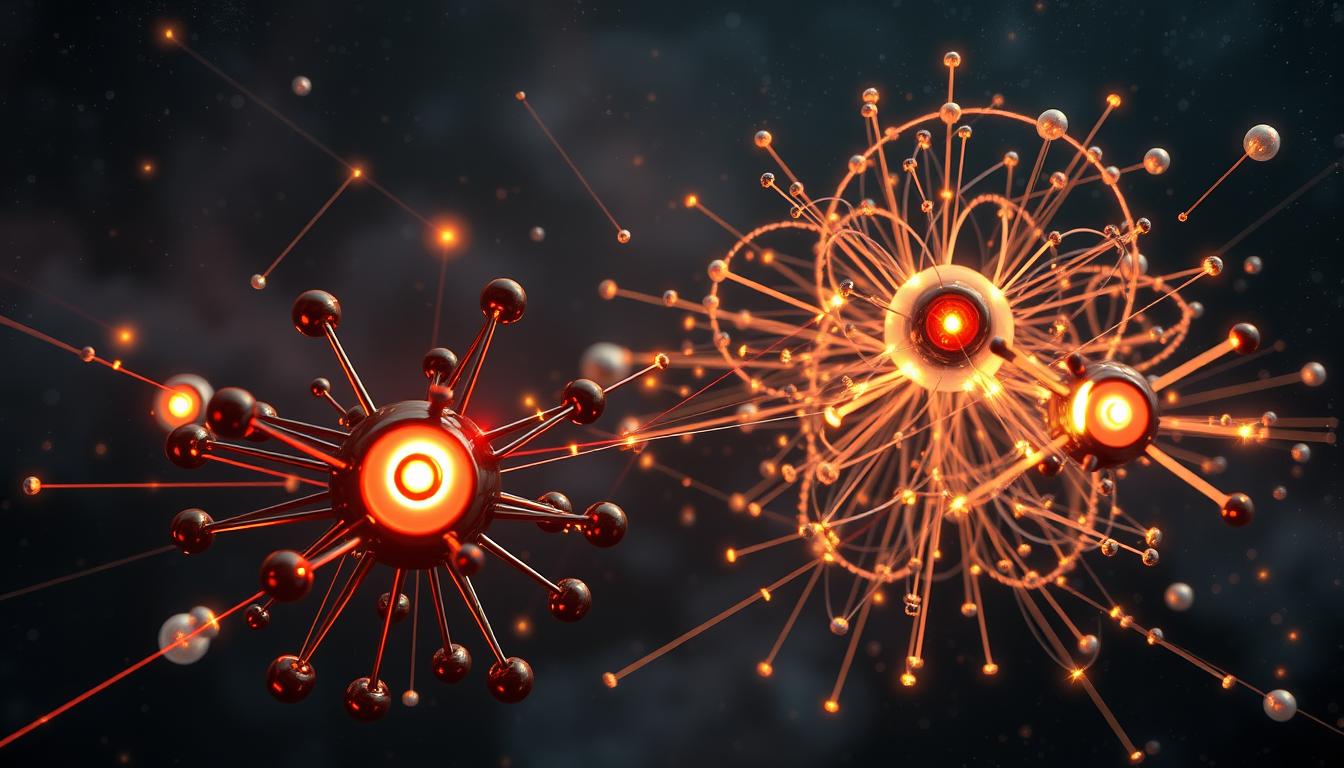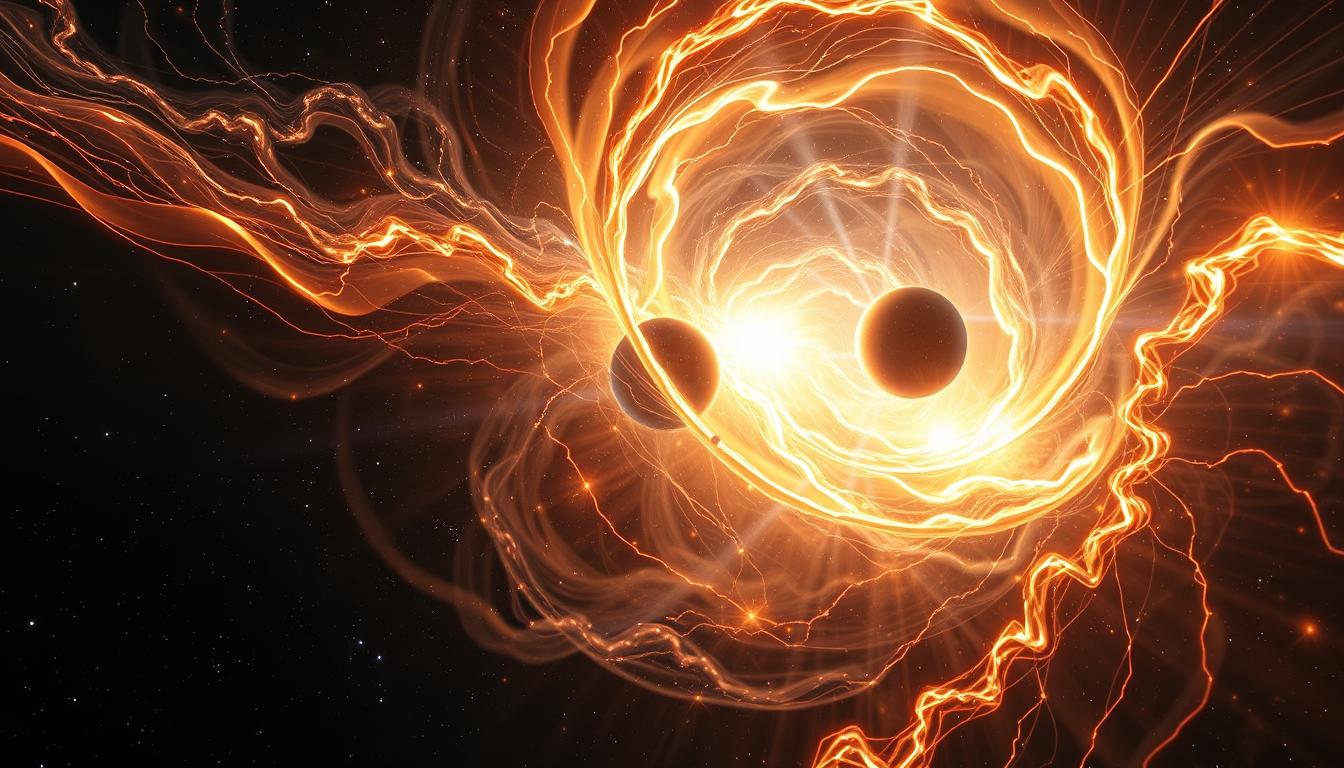If you know a little bit about astrophysics and are interested in astronomy, you probably know that there are invisible things that shape the entire universe. Certain particles vanish in a flash of energy when they meet their counterparts, and many more interesting things. Dark matter and antimatter are two of those invisible things. Both sound like something straight out of a sci-fi movie. They are two of the most fascinating mysteries in modern physics and are different things. But how do you compare antimatter vs dark matter?
Dark matter is unseen but exerts a powerful gravitational pull that holds galaxies together. On the other hand, antimatter mirrors regular particles and annihilates upon contact with them, releasing energy. Both play crucial roles in the universe, but we can’t understand them too much.
In this article, we’ll explore how scientists study them using tools like gravitational lensing and PET scans and compare antimatter vs dark matter. You’ll also learn about their properties, the experiments uncovering their secrets, and their implications for our understanding of the universe.

Why “Matter” is a Thing and What Is It?
From the tiniest particles to the largest galaxies, some sort of matter exists in the universe. Some are part of building the universe, and some do other things. Before I explain dark matter and antimatter and compare antimatter vs dark matter, I should explain a little bit about what matter is.
Matter is everything you see, touch, and occasionally trip over, like your phone, pizza, or your extremely clingy cat. It’s made up of tiny particles called atoms, which are made of even tinier bits: protons, neutrons, and electrons. These particles have mass and take up space. That’s it. That’s a matter. Everything in the known universe (that we can actually see) is made of this stuff. And it’s only about 5% of all the stuff that exists. Five percent! The rest? That’s where dark matter and dark energy come in.
So when we talk about antimatter vs dark matter, we’re talking about two wild relatives of regular matter. They’re weird. They play by different rules, but they’re part of the same extended family.
Dark Matter: Understanding
I want to start with dark matter because it’s much more intriguing (personal opinion!). The universe’s most influential force is something we can’t see, detect, or even know what it is. It’s not a black hole. It’s not antimatter. And it’s definitely not the dark side of the force. Dark matter is…well, mysterious. But we know it’s out there.
You can’t see dark matter, touch it, or smell it. We can feel its effects, and it’s there through gravity. It pulls on stuff. A lot of stuff. Without it, galaxies would just fall apart like a badly built IKEA shelf. While it doesn’t glow, reflect, or interact with light, it affects things around it.
Defining Dark Matter and Its Gravitational Role
So, what exactly is dark matter? The full answer is that we don’t fully know. Dark matter is a mysterious form of mass that doesn’t emit, absorb, or reflect light. Despite this, it does interact with one thing: gravity. It puts a really strong force on gravity and influences the motion of stars and galaxies. Without it, galaxies would fly apart, unable to maintain their structure.
Here’s how we know all this: galaxies are spinning faster than they should be. Based on the amount of visible matter (stars, gas, etc.), they should be flying apart. But they don’t. Something invisible is providing extra gravity to hold everything together. That’s dark matter doing its thing.
One of its key properties is its ability to add unseen mass to cosmic structures. For example, in galaxy clusters like Abell 520, the observed mass is far greater than what visible matter shows us. This difference is the reason why we think dark matter exists.
Observing the Invisible: Techniques and Challenges
Okay, so we know it’s there. But how do you observe something that doesn’t want to be observed? That’s the everyday headache of astrophysicists studying dark matter. Since it doesn’t reflect or emit light, you can’t just point a telescope at it and yell, “Say cheese!”
Scientists rely on indirect methods like gravitational lensing. This technique measures how light bends around massive objects. This shows the distribution of dark matter. It’s like mapping something invisible by observing its effects on the visible thing. Imagine a visible person touching your finger, and your finger moves, like that. Another method is checking how galaxies move. Their motion doesn’t match what we’d expect from just the visible stuff. Stars on the outer edges move faster than expected, suggesting the presence of additional mass.
And then there are direct detection experiments happening deep underground in old mines. Scientists hope that a dark matter particle will one day bump into a regular particle. So far? None. But hope is there. And we have to try. However, indirect detection methods are by far the best ones.
Antimatter: Understanding
Let’s now turn to antimatter. Very different than dark matter, but because of the name similarity, people confuse them a little bit. If dark matter is the quiet type hanging out in the shadows, antimatter is the one making a scene with fireworks. It’s fascinating, rare, and potentially powerful.
It sounds bad, but antimatter is just regular matter’s mirror twin, with a twist. Everything made of matter has an antimatter counterpart: protons have antiprotons, electrons have positrons, and so on. The only real difference? Their electric charge is flipped. One difference that I’ll mention right here between antimatter vs dark matter is that we know antimatter is there, we’ve seen it, and we’ve even created it in labs. But when antimatter meets matter, they destroy each other in a burst of energy. We call that total annihilation.
Fundamental Properties and Creation Processes
Antimatter is defined by its opposite charge compared to regular particles. For example, the electron has a negative charge, while its antimatter counterpart, the positron, has a positive charge. When these two meet, they annihilate each other, converting their mass into pure energy. Both have the same mass and the same behavior.
How does antimatter come to life? Antimatter occurs naturally in high-energy events like supernovae, gamma ray bursts, radioactive decay, and lightning strikes. In labs, scientists generate it by colliding particles at incredible speeds. For instance, Lawrence Livermore National Laboratory physicists created billions of positrons using pure gold.
One interesting fact, though: the universe seems to have way more matter than antimatter. That’s one of the biggest mysteries in physics. Where did all the antimatter go if the Big Bang made equal parts of both? Did the matter cheat? Is there a part of the universe we haven’t found that’s made of pure antimatter? We don’t know. Yet.
Real-World Examples: PET Scans and Natural Occurrences
Antimatter isn’t just a theoretical concept, as I mentioned above. It has practical applications. We see it in real-world use cases. For example, in hospital environments, we use antimatter for certain things. Positron Emission Tomography (PET Scan) uses antimatter to create detailed images of the human body.
A PET scan introduces a radioactive substance that emits positrons into the body. Those positrons bump into electrons, annihilate, and produce gamma rays. These rays are then detected to create detailed images of your insides.
Antimatter also occurs naturally in space. The High-Altitude Water Cherenkov Gamma Ray Observatory detected an excess of positrons above Earth’s atmosphere, hinting at cosmic processes we’re still unraveling. You can also find antimatter in bananas. They emit a tiny number of positrons because of potassium-40 decay.
Antimatter vs Dark Matter: Key Differences in Particle Physics
These two things are fundamental to the universe and how it functions. But they are two different things. They are used for different things by the universe. I’ll show you the key breakdown of their differences and similarities:
- Mass:
- Both have mass, but we know the mass of antimatter particles exactly. Dark matter’s mass is a mystery; we just know it’s massive enough to bend galaxies.
- Both have mass, but we know the mass of antimatter particles exactly. Dark matter’s mass is a mystery; we just know it’s massive enough to bend galaxies.
- Electric Charge:
- Antimatter has the opposite charge of its matter twin (positrons are +1, antiprotons are -1). Dark matter? As far as we know, it’s neutral. It doesn’t interact with light or charge.
- Antimatter has the opposite charge of its matter twin (positrons are +1, antiprotons are -1). Dark matter? As far as we know, it’s neutral. It doesn’t interact with light or charge.
- Interactions:
- Antimatter interacts via electromagnetic and nuclear forces just like matter, but it annihilates when touching it. Dark matter only interacts through gravity (and maybe the weak nuclear force, if we’re lucky).
- Antimatter interacts via electromagnetic and nuclear forces just like matter, but it annihilates when touching it. Dark matter only interacts through gravity (and maybe the weak nuclear force, if we’re lucky).
- Visibility:
- Antimatter can be created and detected in labs. Dark matter? Not so much. No light, no charge, just gravity.
- Antimatter can be created and detected in labs. Dark matter? Not so much. No light, no charge, just gravity.
- Where to Find Them:
- Antimatter shows up in particle accelerators, radioactive decay, and PET scans. Dark matter is believed to make up huge halos around galaxies, silently pulling strings.
- Antimatter shows up in particle accelerators, radioactive decay, and PET scans. Dark matter is believed to make up huge halos around galaxies, silently pulling strings.
Contrasting Mass, Charge, and Interaction Mechanisms
Dark matter and antimatter differ in their mass, charge, and how they interact with other particles. Dark matter is invisible and doesn’t interact with light, but its gravitational pull shapes galaxies. We think it has mass because it pulls stuff with gravity, but we don’t know what kind of particle it is. It doesn’t carry an electric charge (otherwise we’d have seen it), and it doesn’t interact with the electromagnetic force at all.
In contrast, antimatter has the same mass as regular matter but opposite charge, leading to explosive annihilation when they meet. Antimatter particles are basically mirror images of normal particles: the same mass, but opposite charge. So a proton (positive) has an antiproton (negative), and so on. These particles are well understood in terms of how they behave, and we can even predict exactly what happens when they meet their counterparts.

Experimental Approaches and Research Insights
Dark matter is mysterious, and antimatter not so much. In both of these things, there are things we know and there are things we don’t. This doesn’t mean we can move on to the next thing. We still have our experimental approaches to understand them better and conduct research. Especially with dark matter, since that’s the most mysterious one. Some are happening deep underground, some way out in space, and others in high-tech labs filled with magnets, lasers, and an almost suspicious amount of coffee.
Laboratory Investigations: The BASE Collaboration
The BASE (Baryon Antibaryon Symmetry Experiment) Collaboration at CERN is one of the frontrunners when it comes to studying antimatter. Their goal? Compare protons and antiprotons with insane precision to test if the laws of physics treat matter and antimatter equally.
They trap individual antiprotons in a Penning trap and measure properties like charge-to-mass ratios. If they ever find a teeny difference between protons and antiprotons, it could explain why our universe didn’t end in a mutual annihilation fiesta right after the Big Bang.
Using Penning traps, they measure the spin precession of antiprotons with incredible accuracy. For instance, their experiments achieved a frequency measurement uncertainty of just 0.8 parts per billion.
Axion Searches and Quantum Oscillations
As I said, we don’t know what dark matter is. We have some candidates like WIMPs, black holes, and axions. Axions are hypothetical particles. These hypothetical particles are lightweight, weird, and might solve several physics puzzles at once. Scientists are trying to catch them using ultra-sensitive instruments that detect tiny electromagnetic field shifts.
We also explore quantum oscillations, where particles switch identities like cosmic shapeshifters. If dark matter can interact via such mechanisms, it might show up in ways we’ve never expected. That’s why physicists are looking at rare decay patterns, using cold atoms, or even checking the timing of pulsars in deep space.

Linking Dark Matter, Antimatter, and the Big Bang Theory
Dark matter and dark energy together account for 95% of the universe’s content. While dark matter holds galaxies together, dark energy drives them apart. This interplay raises questions about the Big Bang and the universe’s early moments.
If you want to trace these ingredients back to the same cosmic place, this takes us to the Big Bang. This explosive beginning wasn’t just a bang. It was a recipe. And the mix of matter and antimatter was one of its first ingredients. For instance, the Big Bang created equal amounts of matter and antimatter. But today, there is more matter than antimatter. Why? We don’t know.
At the same time, dark matter seems to have shaped the universe’s large-scale structure by forming invisible scaffolding for galaxies to form around. And dark energy? It’s been pushing galaxies apart ever since, causing that expansion to accelerate.
Understanding how all three of these elements emerged during the Big Bang could solve multiple puzzles at once. But we’re still piecing it all together, one particle, one equation, one wildly expensive experiment at a time.
Conclusion
So dark matter and antimatter are totally different things. Newcomers to astrophysics and astronomy often confuse them, but each is wildly important in their own way. One is the universe’s invisible scaffolding, holding galaxies together like cosmic duct tape. The other is a volatile mirror twin of matter, ready to explode at the slightest touch in a blaze of gamma rays.
That’s why comparing antimatter vs dark matter is not a hard task in its definition. The hard part of the antimatter vs dark matter discussion is to go beyond the current mysteries. Because both are quite mysterious. We don’t fully understand either of them (yet), but trying to figure them out has pushed science to build giant underground labs, smash particles together at near-light speeds, and stare deep into the universe with telescopes that cost more than a small country’s GDP.
But we continue to try to understand them. Especially dark matter, since it is probably the most mysterious thing in the universe. Antimatter is a bit more understandable since we can see, detect, and create it.
FAQ
What is the difference between dark matter and antimatter?
While both are fascinating cosmic phenomena, dark matter is a mysterious substance that doesn’t interact with light but exerts gravitational force. On the other hand, antimatter consists of particles with charges opposite to regular matter, like positrons, which are the counterparts to electrons.
How do scientists detect dark matter if it’s invisible?
Researchers use indirect methods, such as observing gravitational effects on galaxies and cosmic structures. Techniques like gravitational lensing and studying the rotation curves of galaxies help infer its presence.
Can dark matter and antimatter interact with each other?
There’s no evidence suggesting direct interaction between the two. Dark matter primarily interacts through gravity, while antimatter interacts via electromagnetic forces, making their paths distinct in the universe.
Why is antimatter so rare compared to regular matter?
During the Big Bang, a slight asymmetry favored the creation of regular matter over antimatter. This imbalance, known as baryon asymmetry, is one of the biggest unanswered questions in physics.
What role does dark matter play in the universe’s structure?
It acts as a cosmic scaffold, providing the gravitational pull it needs to form galaxies and clusters. Without it, the universe’s large-scale structure wouldn’t be as we know it.